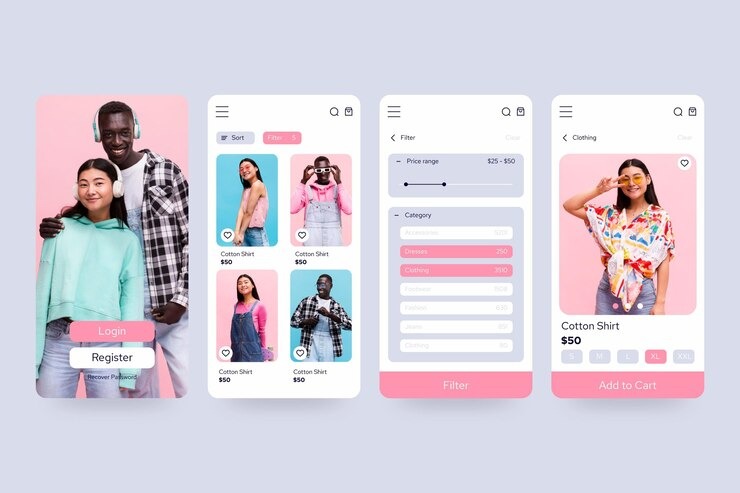Just imagine it’s heavily raining outside and you’re just curled up on the couch and scrolling through a shopping app. Within minutes, you find the perfect pair of shoes for the office, you tap on the “buy now” button, apply a deal, make a payment using an integrated payment method and get the delivery of the product the next day.
Sounds amazing, right!
The purchase is seamless, personalized, and incredibly satisfying.
This is the magic of a well-built eCommerce mobile app.
Well, every leading mobile app development company in India offering ecommerce mobile app development services has surely seen how digital storefronts can create real connections and are able to transform every click into a potential sale.
A great app doesn’t just sell products—it delivers convenience, trust, and delightful experiences.
If you’re a business aiming to boost your digital presence and revenue through ecommerce app development, then this blog is for you.
Let’s break down the steps, features, and trends that define successful eCommerce app development today.
Why Invest in eCommerce App Development?
With the availability of leading giants like Amazon, Walmart, the ecommerce market still has room for new ecommerce apps that can address the gap between the changing requirements of the customers and increasing market demands.
Even with various apps, Mobile eCommerce or mCommerce accounts for over 73% of total eCommerce sales globally. As smartphones become the primary shopping channel, businesses are investing in eCommerce apps to offer seamless, responsive, and intuitive shopping experiences.
So you are all set to build an ecommerce app but not sure where to start, then hire software developers who can help customize the solution as per your business requirements.
Let’s jump to the step-by-step process of developing an ecommerce app:
Steps to Develop an eCommerce App
1. Conduct Market Research
Usually, businesses rush to jumpstart their app development process without any market research, which is a major blunder. Take note of competitors and try addressing the gap by offering feature-rich apps.
2. Understand Your Target Audience
Before you get into the process of developing an ecommerce mobile app, decide whether you are looking for a B2B, B2C, C2C or subscription-based app. Your ultimate target audience will help you decide what type of app you would require for the business.
3. UI/UX Planning & Design
Hire mobile app developers to create wireframes and user journey maps. The design should prioritize simplicity, speed, and user engagement. Ensure easy navigation, high-quality images, and a mobile-friendly interface.
4. Technology Stack Selection
Choose the best choice of technology as the ultimate performance will depend upon the tools, frameworks, and programming languages you pick for the app developers. For example, for the frontend, you can choose React Native as it offers ready-to-use UI components, and for the backend, Node.js will be the ultimate choice.
5. Development & Testing
Agile development methodology is preferred to allow iterative testing and faster deployment. QA testing should include usability, security, performance, and cross-platform compatibility testing.
6. Launch & Deployment
Deploy the app on platforms like Google Play Store and Apple App Store. Ensure that ASO (App Store Optimization) strategies are used for visibility.
7. Post-Launch Support
Regular updates, bug fixes, feature enhancements, and customer support ensure long-term user engagement and retention.
Key Features of a Successful eCommerce App
Features and functionalities are the major budget eaters of any app. To compete with the leading ecommerce app, you need to integrate plenty of features that may add to the budget and development time. Therefore, here we are listing the must-have features for the ecommerce app development:
- Easy User Sign-up: Allow users to easily sign up via email, phone, or social logins and keep the process short, easy, and simple.
2. Smart Product Search and Filters: Implement auto-suggestions, barcode scanning, and AI-powered filters to help users find the right product without having to number of pages.
3. Add Product Listing with Descriptions: Provide visually appealing product pages with descriptions, specifications, reviews, ratings, and videos to enhance buying confidence.
4. Wishlist and Product Cart: Enable users to save items for future purchases or modify their cart before checkout by allowing them to quickly add a product that they wish to buy later.
5. Multi-Platform Payment Gateway: Integrate multiple payment options: debit/credit cards, UPI, wallets, net banking, and cash on delivery (COD).
6. Real-Time Order Tracking: Real-time tracking, estimated delivery time, and push notifications keep users informed.
7. User Feedback: User-generated content builds trust and influences purchasing decisions.
8. Personalized Product Recommendations: Machine learning algorithms suggest products based on user behavior and preferences.
9. Reminders and Alerts: Send personalized alerts about offers, cart abandonment, order updates, and more.
10. Multi-Lingual and Currency Support: Crucial for global reach, especially in cross-border commerce.
Final Thoughts
In this digital era, ecommerce shopping apps will continue to dominate the market. Ecommerce apps no longer remain an option for businesses; rather, it has become a strategic need to survive. From intuitive UX design to AI-driven personalization and real-time analytics, the potential of eCommerce apps is vast and evolving. Therefore, hiring a software development company to launch your ecommerce app with the right set of features will be a worthy decision.




























































